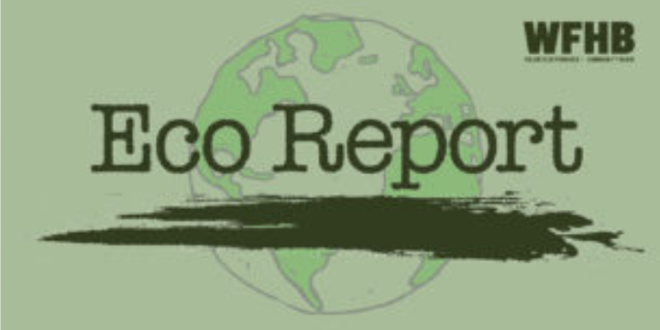Podcast: Play in new window | Download (Duration: 28:04 — 38.6MB)
| Hello and welcome to Eco-Report. For WFHB, I’m Julianna Dailey. And I’m Frank Marshalek. Coming up later in today’s program, Environmental Correspondent Zyro Roze brings us a conversation on Local Food Security amidst Global Challenges in Part Three of a series with Jami Scholl of ReZENience, a permaculture health consultancy in Bloomington. |
|
And now for your environmental reports: Inside Climate Change reports republicans are doubling down on their attacks on clean energy and climate spending. This kicks off their return to Congress with a slew of bills and amendments that would block key funding pools established under the Inflation Reduction Act and prohibit the federal government from advancing policies aimed at reducing the nation’s greenhouse gas emissions, according to new reports. Congress must pass a number of spending bills by Sept. 30, when current funding expires, to avoid a government shutdown. While Democrats and Republicans narrowly avoided a U.S. default last month when they reached a fragile deal to raise the debt ceiling, this week’s budget talks already appear to be on shaky ground as far-right members of the GOP continue to frame climate action and other progressive concerns through America’s culture wars. In fact, environmentalists are accusing House Republicans of sabotaging any chance for a budget deal this fall by slipping so-called “climate poison pills” into their spending proposals. A poison pill is an amendment to a legislative bill that considerably weakens the bill’s intended effect or ruins the bill’s chances of passing. —Norm Holy |
| The National Environment Satellite, Data and Information Service (NESDIS) is part of the National Oceanic and Atmospheric Administration (NOAA) and reports on the status of Florida’s coral reefs. They say that if ocean temperatures are higher than the maximum monthly average, for a month or more, especially during the warmest part of the year — even by as little as 2-3 degrees Fahrenheit — corals will experience bleaching. A bleached coral is essentially starving to death because it has lost its main source of nutrition — the algae that live symbiotically within its tissues. The damage corals experience from marine heatwaves is a function of the duration, or how long the heat stress occurs, plus the magnitude of the heat stress.Corals can recover from bleaching if the heat stress subsides, but the corals that are able to recover frequently have impaired growth and reproduction, and are susceptible to disease for two to four years after recovery. There are downstream, negative impacts to the corals that are able to survive a heat stress event. If the heat stress does not subside, the coral will die. Mortality becomes likely if the corals experience sea temperatures 1°C greater than the historical maximum monthly average for two months, or 2°C greater than the maximum monthly average for one month. Also, if there is a temperature deviation of say 3°C, then the corals would be expected to start experiencing mortality in less than three weeks. Many corals grow optimally in water temperatures between 73° and 84° Fahrenheit, but some can tolerate temperatures as high as 104° Fahrenheit for short periods. During previous, large-scale bleaching events in the Florida Keys (the most recent severe events were in 2014 and 2015), the bleaching-level did not occur until mid-August. So, we are a full month ahead of what we, historically, have called the normal ‘bleaching season’. What this means is, unless significant cooling takes place (for example, repeat passage of hurricanes, or tropical storms), the corals of the Florida Keys may be looking at upwards of three consecutive months of thermally-stressful conditions. This would be unprecedented in the satellite record because most previous bleaching events lasted about four to six weeks. The coral reefs of the Florida Keys have undergone a dramatic decline since the late 1970s, primarily due to disease and coral bleaching, both of which are directly linked to increasing ocean temperatures. Many coral reefs in the Florida Keys have lost much of their coral cover. Recent research by both NOAA and the U.S. Geological Survey has shown that 70 percent of Florida’s coral reef tract is in a net erosional state, which means the reef framework structures are slowly eroding. This is alarming because the many marine species that inhabit coral reefs are directly dependent on the three dimensional, architecturally complex framework structure of coral reefs. We are losing this structure because there is not enough live coral left to maintain and build it. Many species that rely on coral reef habitat are vital to Florida’s economy, such as various fishes, spiny lobster, and stone crabs. We are already losing vital habitat in the Florida Keys that so many organisms depend on for their survival.Changes are occurring so rapidly that it’s difficult to believe the corals can adapt. Perhaps one way to have corals near our coasts is to have migration of the bloom northward. Once a year, on cues from the lunar cycle and the water temperature, entire colonies of coral reefs simultaneously release their tiny eggs and sperm, called gametes, into the ocean. There is little reason to believe the corals around Florida or anywhere in the Gulf of Mexico will survive this summer. Perhaps the best route is to take cuttings from current reefs and plant them along the east coast.—Norm Holy |
| The Spokesman-Review in Spokane, Washington reports an outlook now that we are in an El Niño year. It’s bad news for salmon and steelhead runs up and down the West Coast, including those that return to the Snake and Columbia rivers.
The NOAA Climate Prediction Center said last week that El Niño conditions are now present off the coast of South America, and they can be expected to gather strength by this winter. According to a news release from the agency, the weather phenomenon is identified by the accumulation of warmer-than-normal sea surface temperatures in the Pacific Ocean west of South America near the equator. El Niño (little boy in Spanish) influences global weather patterns. “Depending on its strength, El Niño can cause a range of impacts, such as increasing the risk of heavy rainfall and droughts in certain locations around the world,” said Michelle L’Heureux, climate scientist at the Climate Prediction Center, in the news release. Climate change can exacerbate or mitigate certain impacts related to El Niño. For example, El Niño could lead to new records for temperatures, particularly in areas that already experience above-average temperatures during El Niño. It also influences salmon survival. El Niño brings warmer sea surface temperatures to the northern Pacific Ocean, an area where salmon and steelhead spend their time at sea. Ocean water off the continental shelf that normally is dominated with northern copepods – fat-laden creatures near the bottom of the food chain – are replaced with skinny southern copepods. Young salmon need to pack on weight to survive. But the El Niño-induced diet reverberates up the food web. With less to eat, the survival of juvenile salmon and steelhead generally declines during El Niño years. —Norm Holy |
| Aljazeera reports wildfires have become more intense in Russia in recent seasons, helped by unusually high temperatures in Siberia, driven by climate change. They release millions of tonnes of carbon and other pollutants into the atmosphere each year. Hundreds of fires are burning out of control.
The 2021 fire season was Russia’s largest ever, with 46.5 million acres of forest destroyed, according to Greenpeace Russia – about two times the size of the acreage of Indiana. —Norm Holy |
Up next, we explore ways to achieve local food security through responsive integrative policy and shaping redevelopment strategies that foster, rather than hinder, organic urban agriculture. The full interview with Jami Scholl will become available as an Eco Report EXTRA on the WFHB website. |
| For Eco-Report, I am Julianna Dailey. And, I am Frank Marshalek. Are you looking for a way to make a difference on environmental issues? Here at EcoReport we are currently looking for reporters, engineers, and segment producers. Our goal is to report facts on how we’re all affected by global climate disruption and the ongoing assaults on our air, land and water.
We also celebrate ecologists, tree huggers, soil builders and an assortment of champions who actively protect and restore our natural world, particularly those who are active in south central Indiana. All levels of experience and all ages are welcome, and we provide the training you’ll need. WFHB also offers internships. To volunteer for Eco-Report, give us a call at (812) 323-1200, or e-mail us at: [email protected]. |
|
And now for some upcoming events: Special guest speaker, David Rupp, owner and guide for IndiGo Birding Nature Tours, will be at Wild Birds Unlimited in Bloomington on Saturday, July 22nd, at 4 pm. He will give a presentation on “Understanding Bird Migration.” |
| McCormick’s Creek State Park has a fun-filled, all-day event celebraing Wild About Wildlife on Saturday, July 22nd. Events begin at 10 am with Birding Bingo and end at 7 pm with Wildlife “Tails” by the Campfire. A variety of events take place all day. |
| Goose Pond Fish and Wilflife Area is hosting a Dove Banding Day on Wednesday, July 26th from 1 to 2 pm. You will learn how to check dove traps, learn why the doves are banded and the process of banding. Bring sun protection and insect repellant. Register at [email protected] or call 812-512-9159. |
| Learn about the Life of a Salamander at Spring Mill State Park on Wednesday, July 26th from 3 to 3:30 pm. Learn about their life cycle and what adaptation make them so special. Meet at the Lakeview Activity Amphitheater. |
| Enjoy a Full Moon Hike around Lake Ogle at Brown County State Park on Saturday, July 29th from 9 to 10 pm. The Sturgeon Full Moon is considered a supermoon. You will hike Trail 7 as you learn the history and folklore of the Sturgeon Full Moon and what a supermoon is. |
| And that wraps up our show for this week. EcoReport is brought to you in part by M-P-I Solar, a Bloomington business specializing in solar hot water, solar electricity and solar hot air systems. M-P-I Solar designs and installs solar power generation systems that encourage independence and individual responsibility. Found locally at 812-334-4003 and on the Web at mpisolarenergy.com. |
| This week’s headlines were written by Norm Holy. Today’s news feature was produced by Zyro Roze and edited by Noelle Herhusky-Schneider. Julianna Dailey assembled the script which was edited by Zyro Roze. Julianna Dailey compiled our events calendar. Kade Young and Noelle Herhusky-Schneider produced today’s show. Branden Blewett is our engineer. For WFHB, I’m Julianna Dailey. And I am Frank Marshalek. And this is EcoReport. |
 WFHB Bloomington Community Radio
WFHB Bloomington Community Radio


